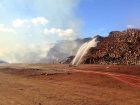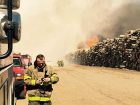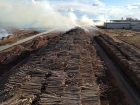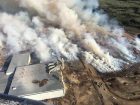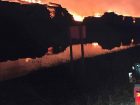
Features
Hot topics
Incident reports
Editor’s pick 2016: Regional Response
In the Peace Region of Northern Alberta, regional co-operation is a top priority for fire departments. This was very evident on May 4, when a fire in a pile of waste-wood material spread to a log yard and threatened the Norbord Inc. oriented strand board plant in High Level.
December 22, 2016
By Rodney Schmidt
 Firefighters from departments across northern Alberta went to High Level to help battle a fire at the Norbord oriented strand board mill in May. Editor’s pick 2016: No. 4 – Rodney Schmidt was at the training ground in Peace River
Firefighters from departments across northern Alberta went to High Level to help battle a fire at the Norbord oriented strand board mill in May. Editor’s pick 2016: No. 4 – Rodney Schmidt was at the training ground in Peace RiverOne of the largest plants in North America, Norbord’s High Level operation produces approximately 860 million square feet of OSB annually. The building alone covers almost 16 acres: the south-end roof is more than 30 metres (100 feet) high; the log yard is almost 1.6 kilometres (one mile) long.
■ The initial call
At 14:15 on May 4, the High Level Fire Department received a call for an outdoor fire at Norbord, approximately five kilometres south of town. The initial dispatch stated that the fire was in a wood-waste pile (known as a hog pile). The HLFD responded with Squad 1, Tender 1 and Aerial 1. On arrival, Deputy Chief Colin Buchan, announced command and saw a fire isolated to the south side hog pile. The wind, being light from the southwest, was spreading the fire toward the plant.
The initial action plan was to attack the fire head on. Aerial 1 tagged up to a hydrant on the east flank of the fire and was going to use a master stream to contain the fire. While charging the hydrant, the wind changed direction and increased. Moving from full visibility to zero visibility, crews backed out of the area, abandoning hoses in place and moving trucks to a safe area.
Reports began coming in that the wind had pushed fire into the mill, and that fires were burning inside the plant. Inside, Norbord’s emergency response team members began battling fire in the wood room and the dry bins (seven storeys in the air.) Deputy Chief Buchan called an all call for all members, and I was notified of a major incident.
■ The region springs to action
At 15:00, I was teaching at the Northern HEAT conference in Peace River, 300 kilometres south of High Level, and received a text from officers in High Level about the fire. I immediately contacted dispatch and asked for Buchan to phone me as soon as possible. He called immediately and said the log yard was fully involved and there were fires in the plant; all High Level apparatuses were on scene with all available members. Alberta Agriculture and Forestry – Wildfire Management was on scene with air tankers and helicopters and they were trying to contain the fires in the plant. Buchan requested whatever resources I could muster.
I called dispatch and asked for all available mutual aid from our closest neighbors.
High Level is a remote community of approximately 4,000 people with a well-equipped fire department – 35 members, 10 apparatuses and support units. The closest mutual aid department is in Fort Vermilion, 85 kilometres away, and at that time could not provide immediate assistance. The next closest? La Crete, 110 kilometres away. La Crete dispatched an engine and tender as well as an engine from its rural station in Blue Hills, about 130 kilometres away. The next dispatch went to Manning Fire Department, which sent an engine company from 200 kilometres away. The High Level Fire Department was on its own for a while.
Meanwhile in Peace River, fire instruction came to a halt and officers from various departments were briefed on the situation unfolding in High Level. The night before, discussions were held about the possibility of sending crews to Fort McMurray to help with the wildfire affecting the city, but the mill fire became a priority as our own region needed assistance.
Capt. Mike Frayne from the Peace River Fire Department and Deputy Chief Trevor Grant from the County of Grande Prairie Regional Fire Service (CGPRFS) took charge of ordering resources. Peace River/County of Northern Lights sent a tender with a crew as well as a support truck and CGPRFS sent and engine company followed by a tender from the (City of) Grande Prairie Fire Department. Meanwhile, I began the trip back to High Level with our three other HLFD members. Hotel rooms and suitcases abandoned in Peace River, we left the training site with bunker gear and SCBA in Squad 3 with lights and sirens for 300 kilometres. En route, we were receiving updates about resources being sent from fire departments across the region, as well details of a local state of emergency being declared for Mackenzie County in the area of the plant, with homes being evacuated.
■ Arrival at the scene
I arrived at the scene at 17:35 and saw what I thought to be our worst-case scenario: our aerial unit was flowing into the mill dry bins on the seventh floor; and the log yard was fully involved, with air tankers doing retardant drops and helicopters trying to keep it within the plant site. I arrived at the command post (which was being operated out of an engine – our mobile command center/hazmat unit was due for delivery the next week) and met with the deputy chief. Buchan’s report was simple: the crew had to abandon the log-yard fire fight due to limited resources. The log yard was being dealt with by tankers and the structural resources were concentrating on stopping fire in the mill. Members of Manning Fire were on scene fighting fires on the northeast corner of the plant, and members from High Level and La Crete were working in the mill on interior fires. Another crew comprising members from High Level and La Crete, and wildfire staff, was off site sprinklering a farm, and evacuation areas were being held by the RCMP. I told Buchan to maintain his present course until I could complete an assessment, and I met with the wildfire incident commander (unified command was in place), Amanda Ashton, and we went up in a helicopter to take a look at the entire scene.
Getting in the air to see the entire scene was paramount. While en route back to High Level, another wind shift occurred and, from the air, a picture began to emerge of the best strategy to save the plant site. A considerable portion of the log yard, including the large portal cranes, had not yet been affected and this was where we were going to make our stand. After checking the area – including a fly over of the houses under threat – I landed, called Buchan and the other officers and crews arriving, and began handing out the battle plan. I transferred command at 19:02, assigning Buchan as plant-protection division; other resources, as they began arriving, were assigned to the log yard to carry out the plan.
■ Battle for the log yard
I had studied log-yard fires: with two of the largest log yards in Canada in our response area, it is paramount that we know how log yards burn and how to fight them. The key is to get ahead of the fire and protect what you have left. The worst plan is to be a moth to a flame and fight the fire. At least initially.
That is exactly the plan we laid out – a flanking position on two sides: protect the mill and at all cost; protect the two cranes that feed the plant. If the cranes collapse, the mill is down for months and the community would experience a massive financial impact.
The initial plan was to create four divisions: log-yard west; log-yard east; log-yard south; and plant protection. Engine companies were assigned to the four areas.
This was a big-water exercise, the likes of which our department had never experienced. Initially, on scene, we had five engines available for tasking – two from La Crete, two from High Level (including a 50-foot aerial), and one from Manning. The High Level aerial was put into place on the log-yard west division to protect the log pile closest to the cranes; this was a tall order, as the log piles are more than 18 metres (60 feet) high and very wide. The aerial had a good water supply, using a 125 millimetre line from a hydrant that worked at 1,100 kpa pressure flowing over 8,800 litres per minute. The High Level aerial extended its boom and began flowing onto the log pile, along with two ground master streams – a Bitzfire nozzle and a solid-stream ground monitor. The Blitzfire nozzle was placed in a fire break that was approximately 15 metres wide, and put on oscillate to strengthen the fire break in the main pile. This truck, and the others, would not shut down until sometime Saturday.
Next into position was the Manning engine, also going in the log yard west. The Manning engine also tied to a hydrant with a 125 millimetre (mm) line, and used a master stream to the south of the pile directly against the fire edge to slow the advance of the fire. This truck was replaced with the High Level engine midway through the first night.
On the opposite side of the log pile in log yard east, the two La Crete engines were put into place across the pile from log yard west division. Both engines deployed Blitzfires and master streams as well as 65 mm handlines to protect the cranes and stop fire spread to the main pile. The challenge on the east side was water supply: there was a deep water source along the length of the east log yard road, but no hydrants. A system was put into place supplying one engine with two, four-inch portable trash pumps from the High Level tender and one 65-mm portable pump from La Crete to supply one engine. The second engine was supplied by a tender shuttle. The shuttle had tenders from High Level, La Crete and Peace River/County of Northern Lights, and was joined the next morning by the City of Grande Prairie Fire Department. By the end of the week, seven fire tenders were being used continuously to supply water to the engines fighting the log-yard fire.
A wildland engine and a High Level engine positioned at log yard south to begin trying to flow water onto the burning pile, and to save a small section of logs in the south. This operation was abandoned during the night due to resources and the little effect it had on the overall success of the operation.
The plant-protection division was charged with ensuring all fires were out inside the building and creating a standby crew for the plant emergency team. This crew used equipment from High Level’s third engine, and stayed in place until Thursday afternoon when a loss stop was declared in the plant.
During the course of the fire fight, the strategy was simple: daytime operations were to hold the line and prevent fire spread; night-shift crews – during times when there was lower fire behaviour – would direct their efforts onto the fire closest to the logs that hadn’t yet been affected. At night, crews would slowly shift the lines to the south to keep pushing the fire away from the main pile. This battle began Wednesday evening, May 4, and continued without break until Saturday afternoon, May 7, when crews finally started to shut down engines and reduce the water flow. At one point Friday afternoon, the entire operation was using more than 36,000 litres per minute (9,000 gallons per minute) on the log pile.
■ Transition to shifts
It didn’t take long on Day 1 to know that this incident was going to be lengthy; the HLFD had been on its own for the first hour or two and the entire department had been committed. Buchan and I decided that after the first night we would split incident command into two operational periods: I took the day shift and Buchan managed the night shift. By late Wednesday evening, we had resources arriving from other departments across the Peace Region and they were being assigned. We were also being notified of other resources that would arrive Thursday morning; the challenge was to organize them into useable shifts with apparatus. We had assigned a staging officer for incoming resources and an accountability officer, someone for check in, and a scribe to record our decisions. A well-site office trailer was ordered and brought in as a command post, and extra communication equipment was ordered and brought to site. Logistics were being handled through the Emergency Operations Center activated at the Town of High Level office. The logistics team arranged meals, equipment, fuel and other needs. The organization of the response was falling into place. The next step was to get our on-site resources split into working shifts.
On Wednesday, the entire High Level department worked through the night because staffing was short. As resources began to arrive, HLFD members were sent home to rest and given a time to report back. I worked until 04:00 Thursday morning, went home to catch some sleep, and returned at 10:00 to relieve Buchan and his crew. By that time, most of the other resources were arriving and we started building schedules. Some departments had arrived the first night only to be told to check into a hotel, get some sleep and report to the command post in the morning for assignment. Almost everyone who had responded from in and out of the community had been working or training through the day Wednesday; some worked a very long first day but by Thursday a schedule was in place and working.
The other challenge was to ensure a credible response was available for other calls in the area. Wednesday night, when Grande Prairie County Regional Fire Service arrived, members were tasked to be a standby crew for High Level response with their engine in case another call came in. Medical responses with EMS were restricted to cardiac arrest calls or fire-related only in order to reduce the manpower needed. Off-shift High Level firefighters were asked to keep pagers on at home in case they were needed for a callout. Fortunately there was just one MVC during the course of the incident.
■ Water supply crucial
The Norbord OSB plant is protected by a five-million gallon fire pond supplied by two fire pumps – one electric pump and a back-up diesel pump. During the course of the fire fight, both pumps were running at full capacity, supplying water to the engines and tenders. It quickly became apparent that the water supply would not last long. Enter the Norbord team: its members were tasked with keeping the fire pond full.
That task involved many facets: first, pumps were set up to move water from other retention ponds to the main pond. An agricultural pump was used to move water through six-inch aluminum pipe. This worked until the pond from which it was pulling water from ran dry. A fleet of more than 20 commercial water trucks sucked water from every slough, dugout and creek they could find to transport it and dump it into the fire pond. A Cat was brought in to blaze a trail through some forest to another slough, where more pumps were brought in to transfer water. By Friday, the water trucks slowly began to gain on the pond, out-pacing fire crews in water use. Without these water-truck crews, the fight to save the mill would have been lost for sure.
■ Under control
By Friday afternoon things were starting to look up. On Thursday, all issues inside the plant had been taken care of, and standby crews were taken off line to join the log-yard fight; the third High Level engine was released and was assigned on Friday to attack fire in the southeast end of the log yard; it eventually tied to a hydrant supply and attacked the main log pile.
There were also some surprises Friday that caused an increased response. The County of Grande Prairie engine had been kept in reserve to assist with High Level calls was pressed into service due to a flare up in some previously unaffected logs. This fire grew rapidly and resulted in a second tender-shuttle operation. Resources were requested from Fort Vermilion and Slave Lake, and arrived later that afternoon. The Fort Vermilion tender was immediately put into service and a tender from Manning arrived to assist with the shuttle. Slave Lake arrived with an engine that was placed into reserve status for callouts in High Level.
By Saturday afternoon the blaze had subsided to the point at which an under control could be called. No further fire spread was anticipated. A meeting with Norbord staff was held to discuss turnover the next day. By this time, a private fire contractor had arrived to assist with water supply to the fire pond; the mill had contracted the company to bring an engine to the site for standby and fire patrol.
Saturday evening we began to release of resources back to their home stations.
By Sunday afternoon, a turnover was made to mill staff and the last fire engine returned to the High Level fire hall at 18:00.
■ Relationships key
While this incident tested everyone over the course of five days, the response was deemed a huge success. The plant was reopened within two weeks; almost 50 per cent of the log yard was saved, giving the plant enough material to keep running while more wood supply was accessed. Hundreds of jobs were saved and the HLFD had a big win fighting the biggest fire in its 50-year history.
None of this could have been accomplished without relationships. Norbord has been an avid supporter of the HLFD and regular visits and meetings are held with the company in relation to fire protection. The knowledge the HLFD crews have with the plant is second nature, which made a huge difference to the outcome of the incident: because we knew each other, we could have real conversations about expectations, outcomes and eventualities of this large incident.
Another relationship that was key to success is that with Alberta Wildfire Management: the bond is deep and personnel were instantly on board, assisting with air support, unified command on the first day, and providing resources. Keep in mind that this
incident began during the largest urban interface fire in Alberta – Fort McMurray was burning.
Finally, the relationship among fire departments in Northwest Alberta is second to none. Without hesitation, 13 fire departments came together with 75 firefighters to accomplish what seemed an impossible task. Our neighboring fire departments came to assist from up to 640 km away. To some in Canada, that’s a long distance but to us in Northern Alberta, that’s our neighbors. Recently the Northwest Region developed the Northwest Alberta Emergency Resourcing Agreement. This agreement, designed like a mutual-aid agreement, was developed to assist each other in times of major emergencies with pre-determined rates for response, delegation-of-authority forms, and resource-ordering directions. This agreement was still under final signing by municipalities when the incident occurred, and the region responded under the agreement even though the ink had barely dried. The reason for this is the relationships that have been built across the area.
■ The final numbers
- Five-day fire event
- More than 20 apparatus
- 75 firefighters
- More than 6,000 feet of hose used
- More than 20 commercial water trucks
■ Fire departments assisting
- High Level Fire Department
- La Crete Fire Department – 110 km away
- Fort Vermilion FD – 85 km away
- Rainbow Lake Fire Department – 145 km away
- Manning Fire Department – 200 km away
- County of Northern Lights Fire Department – 250 km away
- Peace River Fire Department – 300 km away
- Berwyn Fire Department – 300 km away
- County of Grande Prairie Regional Fire Service – 450 km away
- City of Grande Prairie Fire Department – 450 km away
- Municipal District of Smoky River Fire Department – 350 km away
- Municipal District of Big Lakes – 450 km away
- Lesser Slave Lake Regional Fire Service – 470 km away
- Grand Cache Fire Department – 640 km away
■ Lessons learned
- Get big quickly!
- Plan ahead and know your hazards
- Build relationships with your area departments and key players
- Do not rush to the flame
- Pick a line in the sand and hold the line.
Print this page
